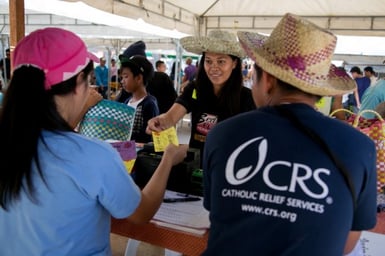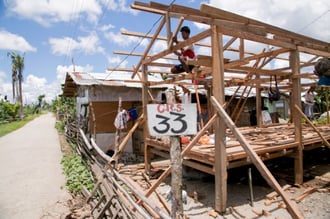Last night, when I drifted off to sleep, I did so with prayers on my lips for the families of the Philippines, who were then awaiting the impact of Typhoon Rammasun. Before going to bed, I had requested the following interview with Elizabeth Tromans, a Regional Technical Advisor for Emergency Preparedness and Response for Catholic Relief Services Living in Manila. Elizabeth was prompt to reply with the following remarks. I'm relieved this morning to read the news that the twelve million living in Manila were spared when the storm swerved, but there is still loss of life and damage to homes. And "Glenda" is a good reminder that there are many in the region who are still suffering from the impact of Haiyan such a short time ago. Please read Elizabeth's remarks below and keep these families in your prayers.
Q: Could you bring us up to speed on the impact of Typhoon Rammasun as it makes landfall in the Philippines?
Here in Metro Manila we've been experiencing heavy rain and wind since the early hours of the morning, as TY Rammasun approached the area having already crossed through northern Samar and the Bicol region of the Philippines. The sustained winds near the center of 150 KM per hour, with gusts up to 185 KM per hour, have caused trees and power lines to fall down. The local parishes in the areas where Rammasun has already crossed are also reporting some flooding. There are power outages in some areas, but so far the cell phone signals have remained functional. We're keeping a very close eye on the water levels especially around the Metro Manila area, which are highly prone to flooding and where people often live in very simply, poorly constructed homes along waterways. Just within the last 10 minutes I'm noticing the rain letting up in my area of Manila as Rammasun continues to move to the west. As the day goes on we will know more about the impact from our dioceses.
 Q: This is a region which was devastated so very recently by Haiyan. Why is this storm so dangerous and what impact will the people in the region face?
Q: This is a region which was devastated so very recently by Haiyan. Why is this storm so dangerous and what impact will the people in the region face?
This storm was particularly heart wrenching to see approaching since we know there are so many families still living in tents and makeshift shelters. The rebuilding needs have been overwhelming and thus 8 months on, many families have not been able to rebuild safe and durable homes outside of the high risk areas. This includes nearly 6,000 families across the affected area who are still living in evacuation centers or tents; this number doesn't capture the many thousand living in makeshift shelters in risky areas. The government with partners from the organizations responding were able to evacuate many people to safe areas and fortunately Rammasun passed just north of the path Haiyan took last November. These areas experienced very heavy rain but were in safe places, and the rain has stopped today and hopefully this means people will be able to return. We're still concerned about northern Samar and will await news from assessment teams in that area on what they're seeing.
Q: How are relief effort donations made by families during a typhoon's aftermath used to help families in the region?
These funds are used to help us mobilize very quickly. When we know we have support coming in from around the world, that allows us to immediately get into the affected areas, find out what the needs are, and quickly address those needs. Oftentimes after typhoons in the Philippines, the urgent needs are clean drinking water and hygiene items like soap, as well as emergency shelter.
 Construction on a CRS-designed home.
Construction on a CRS-designed home.
When Typhoon Haiyan devastated the Visayas in central Philippines in November 2013, families on the eastern side of Leyte island were hit particularly hard as their homes and livelihoods were destroyed. CRS is helping families with individual approaches to transitional shelter.
Q: What are some of the longer term goals for CRS helping in the Philippines?
CRS's vision in assisting communities to recover from an emergency is that we help to create a more safe, durable, and sustainable community. When we're looking at shelter reconstruction, for example, allowing the community to lead the process with our support means that they will find the housing option which is best for them and their family. We always aim to build back better! Our expert architects and urban planners are continually providing support to our engineers on the ground who are helping families rebuild. We also make sure to look at the entire settlement of the community, not only the houses. This might mean improving draining or moving some lots so shelters are reconstructed in a safer area.
Q: How can readers help?
Of course we would love for readers to send their prayers to the affected communities, as well as to the government and non-government groups like CRS who will do our best to assist them. Additionally, donations are what allow us to act swiftly so people can donate to our efforts on www.CRS.org.
About the Author

Lisa M. Hendey
Lisa M. Hendey is the founder of CatholicMom.com, a bestselling author and an international speaker. A frequent radio and television guest, Hendey travels internationally giving workshops on faith, family, and communications. Visit Lisa at LisaHendey.com, on her Substack at LisaHendey.Substack.com, or on social media @LisaHendey for information on her speaking schedule or to invite her to visit your group, parish, school or organization. Find Lisa’s books on her Amazon author page.




.png?width=1806&height=731&name=CatholicMom_hcfm_logo1_pos_871c_2728c%20(002).png)
Comments